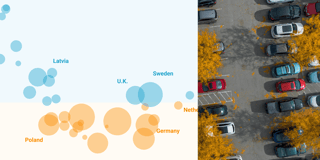There are no 1.7 Earths
Hi, this is Simon, I am a software engineer at Datawrapper. For this week’s edition of the weekly chart, I took a look at ecological footprint data.
July 29th was this year’s Earth Overshoot Day. On this day, we had used up all natural resources that our planet can regenerate within the current year. We call this deficit the ecological overshoot. Humanity continues to exceed what Earth can renew and falls back on reserves which have been built up over millions of years.
Ecological footprinting
The ecological footprint is a metric for the ecological assets that the population of a given region consumes – for example, livestock, plant-based food, timber, and space used for urban infrastructure. It also includes the ecologic impact of waste, particularly carbon emissions. The ecologic footprint is compared with the region’s biocapacity, which is a metric for its capacity to absorb waste and generate new resources, e.g. through forests and cropland. If the ecological footprint of a region is higher than its biocapacity, it runs an ecological deficit. A region with an ecological footprint that is lower than its biocapacity has a ecological reserve.
Ecological footprints differ vastly between countries and correlate heavily with economic wealth. To visually compare footprints around the world, I created a chart with a curve for every region the Global Footprint Network API has data on. Then I highlighted the five countries with the biggest economies according to their GDP (PPP).
This chart illustrates: Four of the five biggest economies are deep in ecological deficit. If every person in the world would live like a resident of the United States, we’d need the equivalent of 5 Earths. For Germany, it would be 3 Earths, for Japan 2.7 and for China 2.2. India still has an ecological reserve, but its ecological footprint has grown steadily.
Chart choices: Line charts and log scales
For this post I created two very different line charts. With the first chart I wanted to emphasize the ecological deficit and reserve, so I highlighted them using the new area tool which lets you fill the area between two lines with a color. The idea for this chart came from graphics used in the Ecological Footprint Explorer.
With the second line chart I wanted to illustrate the world’s vast inequality in terms of ecological footprints. For this, I put data for more than 220 regions into a single line chart and customized the chart’s appearance to make the important information stand out. But there was a problem: Just like in my last weekly chart, there is a very strong concentration of countries at the lower end of the scale, which makes it difficult to visualize the data without too much overlap between important data. Once again, I worked around this issue by using a log scale. Log scales give more prominence to the bottom half of the scale but can also be misleading – in the above line chart they visually reduce the extreme differences between the countries at the top and the bottom of the scale.
By the way, in April 2018 we featured a completely different chart that was based on the same data set: This excellent scatter plot by french information designer Edith Maulandi.
That’s it from me for this week. As always, do let me know if you have feedback, suggestions or questions. I am looking forward to hearing from you at simon@datawrapper.de, Mastodon, or Twitter.



